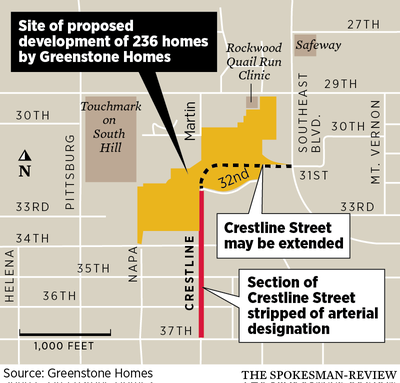Crestline Street loses arterial designation on South Hill much to the approval of developers looking to add 236 homes in area

Crestline Street on Spokane’s South Hill is no longer considered a major road after a decision made Monday night by the Spokane City Council.
The vote, which affects a short portion of the street, could help determine the future for a proposed major housing development near 29th Avenue and Southeast Boulevard.
At issue is traffic in the growing part of town where a developer has plans to build upward of 236 residential units and 38,000 square feet of office, retail and commercial space on 25 acres of land still largely covered in trees, shrubs and grasses.
“We have a housing crisis,” said Council President Ben Stuckart, who said he received at least 200 emails supporting the council’s ultimate vote. “We have to build more housing in our community.”
The remaining question is whether a short extension of Crestline should exist at all. Currently, Crestline peters out after turning into 32nd Avenue and a dead end. The council is set to hear that issue on May 20 when it decides whether to overturn a hearing examiner’s decision that said the street had to be extended through the development to comply with the city’s long-term comprehensive plan, which guides development in the city.
This vote may be avoided. Greenstone, the developer, and Kelly Puzio, who lives near the development, are in negotiations with the city to amend the hearing examiner’s decision. If they come to a stipulated agreement with the city, City Council action would be avoided.
Jim Frank, founder of Greenstone, did not respond to a request for comment.
Most people who spoke to the council on the issue Monday supported the vote to strip Crestline of its arterial status while also speaking in favor of the development. Others said the road extension shouldn’t be allowed at all or that the city should focus its traffic concerns on renovating 29th Avenue and Regal Street.
Ultimately, the full council voted unanimously to remove the arterial designation.
Councilwoman Karen Stratton said she received 108 emails on the subject, which she called “admirable.”
Councilman Mike Fagan, who a year before had voted against a similar proposal, said he would follow what he saw as the will of the people. “We have definitely been lobbied a lot,” he said, adding that he hopes the decision doesn’t create more problems in the future.
Councilman Breean Beggs said the Lincoln Heights neighborhood is an example of what “people power” can do to “seize control of their destiny over their neighborhoods.”
Monday’s vote moved the project by Greenstone, which is also behind Kendall Yards, closer to reality.
The so-called Garden District has faced hurdles since the project plan was announced in March 2018, most relating to the roads the development would build. Greenstone and neighbors have tried to stop Crestline from being extended through the project, citing increased traffic and safety concerns.
After the hearing examiner’s decision requiring the street extension, Greenstone appealed, as did 58 people living in the area in a second appeal that was supported by the Lincoln Heights Neighborhood Council.
This week’s decision affirms a vote by the council in June 2018 when the council unanimously supported a resolution removing the Crestline extension from the comprehensive plan. Councilman Mike Fagan was absent during the vote.
Monday’s vote to remove the designation of “urban major collector arterial” from Crestline affirmed the earlier decision. Under the previous designation, Crestline was considered an arterial for its developed section between 32nd and 37th avenues, as well as for its undeveloped portion south of 32nd to its connection with Southeast Boulevard.
With the change in designation, stop signs will not be placed on side streets that intersect with Crestline, it won’t have as direct of an alignment as an arterial, meaning it will have more “twists and turns,” and it could receive some traffic-calming elements, like roundabouts and extended curbs on corners, Inga Note, a transportation engineer, said at the meeting.